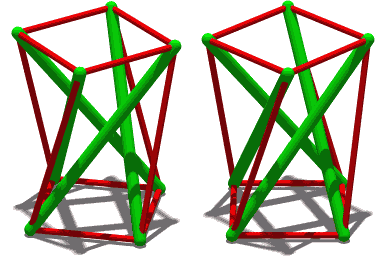Tensegrity
| Stereo image
|
||
|
||
|
||
|
||
|
||
| Animation The simplest tensegrity structure. Each of three compression members (green) is symmetric with the other two, and symmetric from end to end. Each end is connected to three cables (red) which provide compression and which precisely define the position of that end in the same way as the three cables in the Skylon define the bottom end of its tapered pillar. |
| Stereo image
|
||
|
||
|
||
|
||
|
||
| Animation A similar structure but with four compression members. |
Tensegrity, tensional integrity or floating compression, is a structural principle based on the use of isolated components in compression inside a net of continuous tension, in such a way that the compressed members (usually bars or struts) do not touch each other and the prestressed tensioned members (usually cables or tendons) delineate the system spatially.
The term was coined by Buckminster Fuller in the 1960s as a portmanteau of "tensional integrity". The other denomination of tensegrity, floating compression, was used mainly by Kenneth Snelson.
Tensegrity structures are structures based on the combination of a few simple design patterns:
Because of these patterns, no structural member experiences a bending moment. This can produce exceptionally rigid structures for their mass and for the cross section of the components.
A conceptual building block of tensegrity is seen in the 1951 Skylon. Six cables, three at each end, hold the tower in position. The three cables connected to the bottom "define" its location. The other three cables are simply keeping it vertical.
A three-rod tensegrity structure (shown) builds on this simpler structure: the ends of each rod look like the top and bottom of the Skylon. As long as the angle between any two cables is smaller than 180°, the position of the rod is well defined.
Variations such as Needle Tower involve more than three cables meeting at the end of a rod, but these can be thought of as three cables defining the position of that rod end with the additional cables simply attached to that well-defined point in space.
Eleanor Hartley points out visual transparency as an important aesthetic quality of these structures. Korkmaz et al. put forward that the concept of tensegrity is suitable for adaptive architecture thanks to lightweight characteristics.
...
Wikipedia


